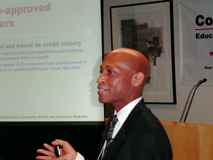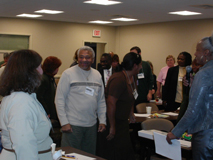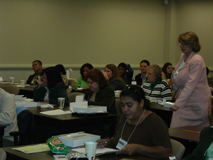MoneyWi$e goes to Massachusetts
Consumer Action's Candance Acevedo lead a number of enthusiastically received sessions on financial literacy for the 2nd Annual MoneyWise Regional Financial Literacy Training held in Norwood, Massachusetts. Over fifty participants enriched the program experience by providing experience and knowledge. A number of useful ideas and tips were generated from the various sessions, and Consumer Action has compiled them in this write-up.
Read all the details of the event in the various 3 subsections.
- Best practices trainers preach “Response Ability"
- MoneyWi$e Tips for Teaching Adults
- Ideas for using the MoneyWi$e financial literacy educational materials
Best practices trainers preach “Response Ability"
A powerhouse trio of train-the-trainers appeared at the most recent MoneyWi$e Regional Financial Literacy Training in Norwood, Massachusetts on Nov. 3. Richard Elam from the Franklin Mint Federal Credit Union of Chester, PA; Lisa Yep Salinas, founder and director of Communications Services of Sacramento, CA and Mary Love Sanford of Fort Valley State University in Ft. Valley, GA brought humor and insight to the “Best Practices" panel moderated by Consumer Action’s Mikael Wagner.
The group led a training on the Experiential Learning Cycle and the Andragogy Planning Process. The term “andragogy" is a theory of how adults learn that emphasizes:
- The teacher as facilitator: helping learners see why something is important to learn
- Learner choice: how to help learners self-direct their learning by teaching them how to access information
- Human experience: How to relate the topic to the learner's experiences
- Readiness: People must be motivated to learn before they can learn
- Bias: Learners need help overcoming inhibitions, behaviors and beliefs about learning
To gauge the expectations of the audience, the panelists asked, “What can we tell you?" The audience came back with a slew of questions:
- How can we partner with other non-profits in our area?
- Has anyone tried buddy systems?
- How do we find funding or charge fees for work?
- How do we keep our participants interested and returning for other sessions?
The group wanted to know about community organizing and program development including basic program design, how long presentations should be, and what’s the best time to host a workshop.
Sanford explained that best practices in the adult training process call for an initial assessment and formative evaluation to meet the needs of the participants. She suggested that during the needs assessment, trainers ask the participants what three things they learned. In creating an evaluation form, she advised, don’t use an odd number of responses, as people tend to give responses that fall in the middle if given a middle category to choose from.
A good training program should contain obtainable goals and objectives as well as tasks. The tasks can be used to check how well each participant is doing. Stanford suggested that when designing and planning a training program, ask yourself “who, what, where, when, how and why or what for." Elam suggesting cultivating the “KISS" approach—Keep it Simple and Smart.
Participants stressed the need for a “summative evaluation" of the program's overall effectiveness. Such an evaluation is key to knowing the value of the program and to provide a basis for reassessing and redesigning the program based on outcomes including participant feedback. A panelist referred to this process as “Response Ability."
During the presentation, the panelists addressed audience expectations:
How do you develop partnerships for referrals?
Lisa Yep Salinas suggested networking and developing partnerships whenever and wherever you can. Salinas said that her relationship with community partners has helped her build a robust referral base. She said that her partners turn to her for help with their trainings and she in turn lets them know about new techniques and funding opportunities when she hears about them.
How do you keep clients engaged and interested in returning?
Elam said he believes in keeping his trainings fun. He often builds trust by sharing personal experiences about money and credit because this makes the audience realize that he is human, too, and that the class is a conversation between equals. Elam keeps his audience engaged by involving them in the presentations and by asking them to share experiences and build on what they already know. He feels that that this awakens creativity in participants and encourages them to share thoughts and ideas.

Salinas incorporates learning objectives to ensure tangible results. When students reach a benchmark, they feel successful and gain a sense of accomplishment, which she believes keeps them involved in the process of learning.
How do you track the success of a program?
The panelists agreed that seeking information from participants before and after presentations is a good way to track what people have learned.
Should training programs rely on incentives?
Panelists agreed that incentives can help bolster attendance and help families in need. They suggested food, raffles, small giveaways and gift certificates.
How do you recruit people who need, but are not required to use, the program?
Elam told how he provides “Lunch and Learn" MoneyWi$e workshops though local employee assistance programs. The employer provides the food and employees benefit from a training on money and credit management while they’re eating. The money management workshop creates interest so that employees sign up for additional MoneyWi$e programs and frequently request workshops for their own departments, said Elam.
How do you recruit quality volunteers?
Elam recruits students from his classes to assist him with workshops. Often these recruits take an interest in volunteering to teach money management workshops. Then, students are comfortable to conduct workshops on their own.
Salinas has access to a diverse volunteer base, where volunteers are interviewed and screened just like any other job applicant. As thanks for serving the community, she gives her volunteers small tokens of appreciation.
What is a good model for financial literacy trainings?
Audience members were invited to modify MoneyWi$e training materials to meet the their needs. The comprehensive materials are free and include training manuals, training guides/curriculums, activities, brochures, handouts and Power Point slides.
How do we find funding?
Sanford suggested searching on web using the key words “life skills grants."
Here are some other suggestions from Consumer Action:
- U.S. Government Grants (www.usagovernmentgrants.org). Provides information about grant money available through the government.
- The Foundation Center (http://fdncenter.org/funders). Click on “Finding Funders"
- Foundations Online (www.foundations.org). Browse the foundation directory, pick a listed foundation, search any foundation's information page or search any foundation's home page.
MoneyWi$e Tips for Teaching Adults
Andrea Wright of Capital One and Candace Acevedo of Consumer Action kicked off the New England MoneyWi$e Regional Training on Nov. 2-3, 2005 with a session on teaching adults. The training was held for community-based organizations who use Consumer Action’s free MoneyWi$e educational materials in their work.
According to the women, the goal of the training on teaching adults was to give attendees a focal point at the start of the two-day training. By understanding why and how adults learn, trainers and presenters can create more effective and successful financial literacy programs for their participants, explained Acevedo.
Tips from the workshop:
- Adults want to learn new skills for a number of reasons: to cope with life changes, to gain new knowledge or skills they need to improve their lives, to increase or maintain their self-esteem, to keep up with rapid changes in their external environment and for personal enjoyment.
- The MoneyWi$e instructor is an orchestrator who ensures that participants feel welcome and are treated as equals and with respect.
- Superior trainers know their subject matter and materials well, which helps them deliver dynamic and responsive presentations.
- For optimal learning, class size should be small (fewer than 30 students).
- Be conscientious about participant’s comfort. At the beginning of class, greet and welcome participants to establish a rapport. Give participants time to introduce themselves. Keep the atmosphere relaxed and informal. Make the MoneyWi$e training fun!
- Draw on students’ life experiences as well as the trainers' own experiences, since adults learn best when teaching is built upon they already know. Ideally, participants will be able to use their new found knowledge to immediately their improve their lives.
- Keep your students engaged. Allow time for participants to ask questions to make sure the information is understood. Take time to break into small interactive groups so students can review and apply what they have learned. Group learning situations greatly improve student comprehension. Encourage students to discuss and share answers. Since most people have short attention spans, try to keep lectures no longer than 30 minutes, stop for questions and answers, and follow up with a learning activity.
- It’s important to diversify teaching approaches and learning styles when presenting to adults. The goal is for students to retain the information and use what they have learned to benefit their lives. We all learn differently, but numerous studies suggest that though reading or seeing information (visual learning), adults retain 5%-10% of the information presented. Through listening (auditory learning), they retain more than though visual learning, 20%-25%. Students retain the most information though psychomotor learning such as performing an activity. The retention rate through learning by doing is 70%-75%. These findings should encourage all trainers to include relevant activities in their workshops to raise the level student success.
Remember: “A good teacher of adults is people-centered, more interested in people than things, more interested individuality than conformity, and more interested in finding solutions than following rules. The teacher must be understanding, flexible, patient, humorous, practical, creative and prepared." from "How to Teach Adults, William A. Draves", The Learning Resource Network

Questions posed to the MoneyWi$e Financial Literacy participants
The MoneyWi$e Financial Literacy participants came up with a positive attributes list and a negative attributes list to the questions posed by the Andrea Wright and Candace Acevedo. These revealing lists may prove useful to MoneyWi$e trainers developing or redesigning programs.
Think about a successful adult class that you’ve attended.
What were some of the attributes that made this class a positive experience for you?
| Attributes that made a positive experience | |
|---|---|
| Class was fun | People felt comfortable |
| Different modes of learning | Meeting new people |
| Interactive | Upfront ground rules |
| Audience participation | Respect for all |
| Real life situations | Introduced each other |
| Instructor not belittling | Name tags |
| Learned different ways of teaching | Learning from other participants |
| Took the shame away from learning | We’re all in the same boat |
| Stayed focused | Parking available |
| Materials to take home | Instructor showed respect to participants |
| Trust. Here to help not hurt | Rewards for questions |
| Instructor knew the clients needs | Trust building |
| Group learning | Know participants needs |
| Not lecturing | Learning from others |
| Felt equal to instructor | Instructor facilitated discussion |
| Did role-plays | Created change |
| Okay to learn from mistakes | Testimonials |
| Provided hand-on tools | Instructor used humor |
| Clear roles between teacher and participants | |
| Leader was understanding and sensitive to participants | |
| Students return to say they’ve learned a lot and the class impacted their lives | |
| Knowing/learning that you are not alone | |
| Instructor practiced with staff peers for feedback | |
| Repeat students because they like learning from you | |
Think about an unsuccessful adult class that you’ve attended.
What made this class a negative experience for you?
| Negative experiences | |
|---|---|
| Teacher monotone | Read from notes |
| Too much information | Being “talked at" |
| Poor time management | Lots of materials with no explanation |
| No support from teacher | Staying on topic |
| No eye contact from class leader | Lack of respect |
| You can’t change all people | |
| Bad habits are hard to break. It takes time to change | |
| Participants not applying what they’ve learned | |
| Teacher was the “expert"; participants were not | |
Ideas for using the MoneyWi$e financial literacy educational materials
At the 2005 MoneyWi$e Financial Literacy Training in Norwood, MA, attendees reported on many creative ways to use Consumer Action’s MoneyWi$e materials.

| Demographics: Who would benefit from MoneyWi$e? | ||
|---|---|---|
| Everyone | Single parents | Low to medium income families |
| Expectant mothers | College students | Victims of domestic violence |
| Homebuyers | Seniors on fixed incomes | People who are re-entering society |
| IDA participants | Ex-offenders | Clients of social services |
| People in debt | Tenant groups | New employees |
| Small business owners | Economics for People Program (EPP) participants | Unemployed |
| Youth | Grandparents | Immigrants |
| Public housing tenants | Co-workers | Public assistance recipients |
| Transitional population | Merchants | Temporary Assistance to Needy Family (TANF) recipients |
| Refugees | Gamblers | Social Security Disability Income (SSDI) recipients |
| People filing bankruptcy | Foster Youth | Alcoholics Anonymous (AA) groups |
| Locations: Where would you present MoneyWi$e? | ||
|---|---|---|
| Head Start locations | Senior Housing | Family service organizations |
| Block parties | Food Pantries | Community Management Team Mtgs. |
| Churches | Extreme makeovers | Community-based organizations (CBOs) serving immigrant groups |
| Clubs | Health Fairs | Consumer education groups |
| Community centers | Unemployment offices | Job training programs |
| Dept. of Social Services | Colleges & high schools | First-time homebuyers’ course |
| Empowerment zones | Non-profit agencies | Homeless service providers |
| Family resource centers | Libraries | Community action programs |
| Banks | Housing programs | Parent/Teacher associations (PTA) |
| Human services groups | Chamber of commerce | Dept of Transitional Assistance |
| Neighborhood meetings | Nursing Homes | Faith-based organizations |
| VITA sites | Job training programs | Collaborate with other agencies |
| Teen shelters | Teen programs | Employee Assistance Programs |
| Pre-release programs | Hospitals | Rental Assistance Programs |
| Publicity: How would you announce your MoneyWi$e training? | ||
|---|---|---|
| PSAs | Radio | Advertise on buses/vans |
| Partnerships | Post announcements | Send fax announcements |
| Newsletters | Networking | Word of mouth |
| Through other agencies | Partner with banks | Employee assistance programs |
| Community Calendars | Flyers | Announce though schools |
| Call people | Private schools | TV - community access |
| Websites / links | Cold-calling | Tell anyone who would listen |
| Mass Mailings | Information tables | Announcements though faith-based organizations |
| Bulletin Boards | Classified Ads | Announcements at community-based organizations |



